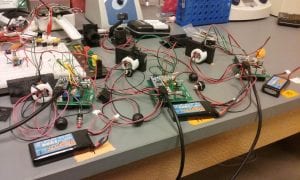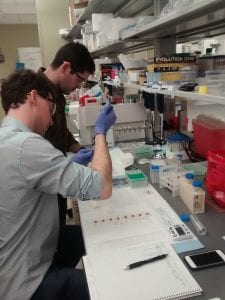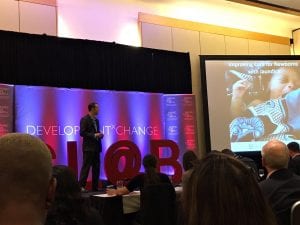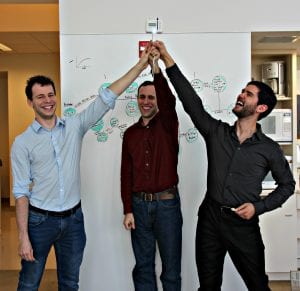For those who may not be familiar, every February an organization called Saving Lives at Birth (SL@B) puts out a call for proposals. They ask for projects that demonstrate “groundbreaking prevention and treatment approaches for pregnant women and newborns in poor, hard-to-reach communities around the time of delivery.” The organization typically receives anywhere between 500-700 applications from universities, companies, and other organizations around the world.
After a careful review, SL@B selects approximately 50 finalists who are then invited to Washington D.C. in late July to present their ideas in person. Grantees who were awarded funding in previous years, investors, and other prominent members of the global health community also attend. During the event, finalists pitch their ideas directly to SL@B officials and the winners are announced at the conclusion of the week-long conference.
My team initially applied for SL@B funding in 2015. At that time, an undergraduate student, Kristofer Schroder, and I had been working on BiliSpec for a couple months. I met Kristopher through Rice’s fencing club and immediately clicked with him. When I pitched the idea of helping me design BiliSpec, he showed great interest. He’s a non-traditional student, returning to school after a stint in the Navy, and on his way to becoming a doctor.
We started working on BiliSpec after two consecutive undergraduate teams had identified a need for a low-cost, rapid diagnostic tool for neonatal jaundice, but hadn’t quite found success with the device itself.
For quick reference: jaundice affects nearly half of all newborns. It has to do with a buildup of bilirubin in the bloodstream. Newborns, lacking a fully developed liver, are unable to process the excess bilirubin, giving their skin a yellow-ish hue. Many cases resolve on their own; but, if the problem persists, the increased concentration of bilirubin can act as a neurological toxin and lead to brain damage.
As I said, we started the project after a few undergraduate teams had come up with the concept. Our initial design was a really crude proof-of-concept disposable for collecting blood and a reader based on a design by the brilliant Meaghan Bond, a postdoc in our lab. Our design was basically a 3D-printed box with wires sticking out of it but, in spite of its looks, we had some really promising results from laboratory testing.
Thankfully (and a little to our surprise), we were selected as a finalist that year; I traveled to D.C and pitched our project alongside my advisor, Dr. Rebecca Richards-Kortum. The week was an exhausting (yet somehow energizing) mix of meetings, interviews, pitches, and general conversation.
That year, BiliSpec not only received $250,000 in seed funding, but also earned the Peers’ Choice Award for “best demonstrating innovative thinking to save lives at birth.” I fondly remember texting Kristopher and sharing the celebration with him over the phone.
In truth, the reason for BiliSpec’s success is the team behind it.
In addition to Kristopher, we added an undergraduate physics major, Mathieu Simeral, to our team. Somewhere along the line Kristofer and Mathieu were affectionately nicknamed the minions. Jokingly, they call me Gru.
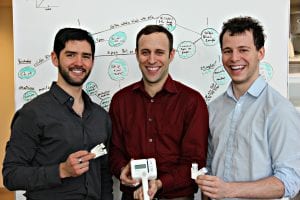
And while I have a nickname that would suggest I’m their leader, the truth is I simply could not have accomplished something of this magnitude on my own. Kristopher and Mathieu have put in countless hours and poured immense passion into this device. (In fact, BiliSpec has been through nearly 40 different design iterations.) Without their dedication, ingenuity, and sheer determination there would be no BiliSpec.
Following our initial SL@B success, Kristopher, Mathieu, and I worked with the lab team at Rice, a phenomenal team at 3rd Stone Design, and clinicians in Malawi over the next two years. Our goal was to build a clinic-ready BiliSpec that not only tackled the technical challenges of accurately measuring bilirubin, but that was also appropriately-designed for use in low-resource settings.
This work culminated in the opportunity to take several BiliSpec devices to Malawi for a clinical pilot study for a few life-altering months. I remember training one nurse, Prince, on the device and watching him use it with minimal problems within an hour. It was incredibly rewarding to see something you created being used to help other people. Getting something to work in the lab is hard enough, but seeing all the little pieces come together so easily and flawlessly on that trip was surreal.
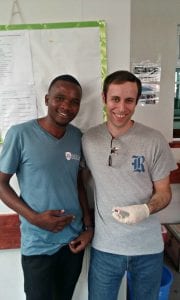
This past week, I had the privilege of representing the BiliSpec project once again at the SL@B DevelopmentXChange event. My team walked away with $500,000 in funding to introduce BiliSpec to five incredibly deserving hospitals in Malawi and to ultimately finalize a commercial-ready device.
It took a heroic effort by many people on the BiliSpec team to get to this point and it certainly didn’t happen overnight. I couldn’t have asked for a better team to work with on this project and I’m excited to see where we take it in the future.
